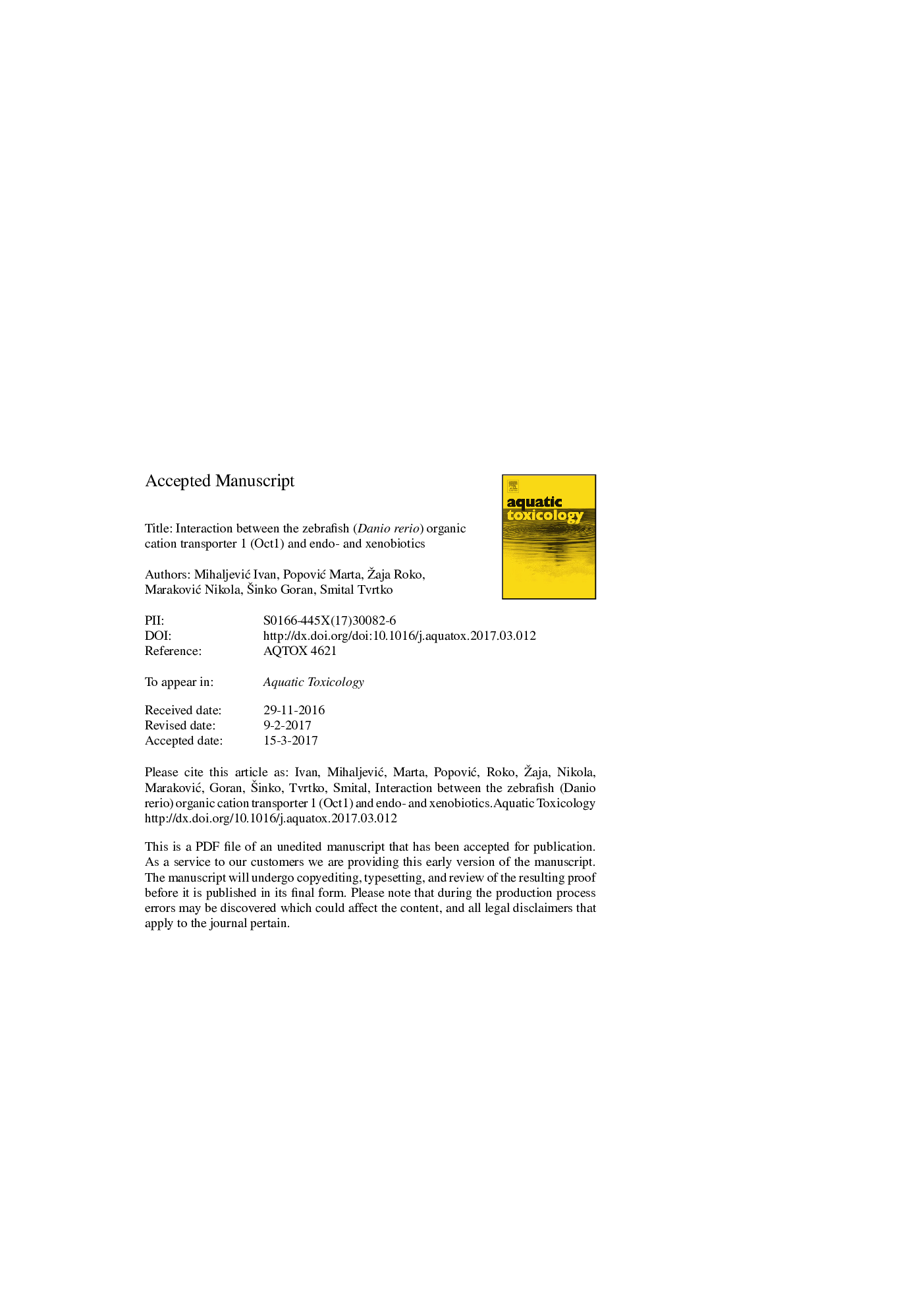| کد مقاله | کد نشریه | سال انتشار | مقاله انگلیسی | نسخه تمام متن |
|---|---|---|---|---|
| 5764291 | 1625918 | 2017 | 28 صفحه PDF | دانلود رایگان |
عنوان انگلیسی مقاله ISI
Interaction between the zebrafish (Danio rerio) organic cation transporter 1 (Oct1) and endo- and xenobiotics
دانلود مقاله + سفارش ترجمه
دانلود مقاله ISI انگلیسی
رایگان برای ایرانیان
کلمات کلیدی
DMEMtetrapentylammoniumOCTsDulbecco’s Modified Eagle's mediumTKIsASP+Tributyltin chlorideTMDsDBT1-methyl-4-phenylpyridiniumTBTTBADAPIADME3-(4,5-dimethylthiazol-2-yl)-2,5-diphenyltetrazolium bromide - 3- (4،5-dimethylthiazol-2-yl) -2،5-difenyltetrazolium bromide4′,6-diamidino-2-phenylindole - 4 '، 6-دیامیدینو-2-فنیلینولMPP+ - MPP +MTT - MTTTetrabutylammonium - tetrabutylammoniumTetraethylammonium - تترا اتیل آمونیومabsorption, distribution, metabolism and excretion - جذب، توزیع، متابولیسم و دفعTransmembrane domains - دامنه های ترانزیستورhuman embryonic kidney cell line - سلول انسانی جنین انسانTyrosine kinase inhibitors - مهار کننده های تیروزین کینازFunctional characterization - ویژگی های عملکردیTEA - چایOrganic cation transporters - کانتینرهای ارگانیکZebrafish - گورخرماهی
موضوعات مرتبط
علوم زیستی و بیوفناوری
علوم کشاورزی و بیولوژیک
علوم آبزیان
پیش نمایش صفحه اول مقاله

چکیده انگلیسی
Organic cation transporters (OCTs) serve as uptake transporters of numerous endo- and xenobiotics. They have been in the focus of medical toxicological research for more than a decade due to their key role in absorption, distribution, metabolism and excretion due to their expression on basolateral membranes of various barrier tissues. OCTs belong to the SLC22A family within the SLC (Solute carrier) protein superfamily, with three co-orthologs identified in humans (OCT1, 2 and 3), and two Oct orthologs in zebrafish (Oct1 and Oct2). The structural and functional properties of zebrafish Octs, along with their toxicological relevance, have still not been explored. In this study, we performed a functional characterization of zebrafish Oct1 using transient and stable heterologous expression systems and model fluorescent substrates as the basis for interaction studies with a wide range of endo- and xenobiotics. We also conducted a basic topology analysis and homology modeling to determine the structure and membrane localization of Oct1. Finally, we performed an MTT assay to evaluate the toxic effects of the seven interactors identified - oxaliplatin, cisplatin, berberine, MPP+, prazosin, paraquat and mitoxantrone - in human embryonic kidney cells (HEK293T) stably expressing zebrafish Oct1 (HEK293T-drOct1 cells). Our results show that the zebrafish Oct1 structure consists of 12 transmembrane alpha helices, which form the active region with more than one active site. Five new fluorescent substrates of Oct1 were identified: ASP+ (Km = 26 μM), rhodamine 123 (Km = 103.7 nM), berberine (Km = 3.96 μM), DAPI (Km = 780 nM), and ethidium bromide (Km = 97 nM). Interaction studies revealed numerous interactors that inhibited the Oct1-dependent uptake of fluorescent substrates. The identified interactors ranged from physiological compounds (mainly steroid hormones) to different classes of xenobiotics, with IC50 values in nanomolar (e.g., pyrimethamine and prazosin) to millimolar range (e.g., cimetidine). Cytotoxicity experiments with HEK293T-drOct1 cells enabled us to identify berberine, oxaliplatin and MPP+ as substrates of Oct1. The data presented in this study provide the first insights into the functional properties of zebrafish Oct1 and offer an important basis for more detailed molecular and ecotoxicological characterizations of this transporter.
ناشر
Database: Elsevier - ScienceDirect (ساینس دایرکت)
Journal: Aquatic Toxicology - Volume 187, June 2017, Pages 18-28
Journal: Aquatic Toxicology - Volume 187, June 2017, Pages 18-28
نویسندگان
Ivan MihaljeviÄ, Marta PopoviÄ, Roko Žaja, Nikola MarakoviÄ, Goran Å inko, Tvrtko Smital,